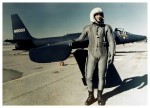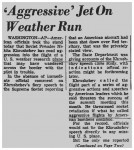
Cold War tensions fuelled a constant demand for up-to-date intelligence about the ‘enemy’. One innovation, developed and built by the United States company Lockheed, was the U-2 spy plane. First constructed in the mid-1950s, the U-2 was a jet aircraft capable of flying at 21,000 metres, twice the altitude of modern passenger jets. This high ceiling allowed it to overfly enemy territory, largely undetected by ‘spotters’ and radar. The U-2 was designed primarily for reconnaissance. Its underbelly contained an array of cameras so powerful they could capture a newspaper headline from miles in the sky. Flying the U-2 was notoriously difficult, however. The aircraft had to be flown at close to maximum speed to prevent stalling; it was very sensitive to crosswinds and troublesome to land. Pilots had to wear high-altitude gear that bore some similarity to spacesuits. American U-2s began secret flights over Soviet territory in mid-1956. To minimise the dangers of discovery, these U-2s were armed with a self-destruct mechanism and their pilots supplied with suicide devices.
In 1960 the US conducted U-2 runs over Soviet bases, test sites and missile silos in central Asia. These operations were conducted by the CIA, largely because the presence of an American military plane over Soviet territory could be construed as an act of war. In April, a U-2 launched from Pakistan played cat-and-mouse with Soviet MiG jets before landing in Iran. Another U-2, piloted by Francis Gary Powers, was launched on May 1st with orders to photograph Soviet installations, including ICBM silos and a plutonium factory. Soviet air defences became aware of this mission and scrambled jets – but the U-2’s altitude prevented it from being located. While flying over the Ural Mountains, Powers’ U-2 was struck by a surface-to-air missile and forced to crash-land. Powers ejected from his crippled plane and parachuted into Russia, where he was immediately arrested, detained and questioned by the KGB.

When Powers failed to arrive at his designated landing site, American commanders assumed he was dead and his plane had crashed or been shot down. Washington informed the press an American plane was missing in eastern Europe – but described it as a “weather plane”. To support this charade, another U-2 was painted with NASA livery and shown to the media, to suggest they regularly undertook meteorological research. Believing Powers to be dead, the US also claimed the loss may have been due to faulty oxygen supplies on U-2s, which caused pilots to ‘blackout’ and fly dramatically off-course. Days after this fictitious cover story was paraded to the world, Soviet leader Nikita Khrushchev sprang his trap. Khrushchev announced that the USSR had possession of an American spy plane; that it had been shot down over Soviet territory; and that its pilot was alive and in custody. The Russians even salvaged film from cameras onboard the U-2. Once developed this film revealed covert photographs of Soviet military and nuclear installations.

The capture of Powers, the U-2 wreckage and its surveillance images triggered a propaganda crisis for the US. Washington had been caught lying and Khrushchev made the most of it, demanding an apology from US president Dwight Eisenhower; Eisenhower refused to do so. Powers’ plane was shot down a fortnight before the start of a four-nation summit in Paris; the U-2 incident torpedoed this conference, which was abandoned on the second day. The US government also had to decide what to do about Powers. After weeks of interrogation by the Soviet military and the KGB, Powers was put on trial, charged with espionage against the Soviet Union. He was found guilty and sentenced to three years’ imprisonment, followed by seven years confinement in a labour camp.
“I have to tell you that the handling of that critical international situation – and it was critical – was about as clumsy in my opinion as anything our government has ever done. We had absolutely failed to consider the ‘what ifs’ of the U-2 overflights in a thorough, realistic and searching manner. The shoot-down was a lesson that was burned into us by the way we mishandled it.”
Andrew Goodpaster
US Army general
Eighteen months after his trial Powers was returned to American authorities, in trade for a captured Soviet spy. The prisoner exchange took place at one of the few transit gates in the freshly-constructed Berlin Wall. Powers was treated with some suspicion on his return to the US. Many asked why he had failed to follow operating procedures for spy missions, such as initiating the self-destruct mechanism in the U-2 and committing suicide to avoid capture. He was fiercely grilled by his superiors at the CIA and then later by a congressional committee. Powers was subsequently found to have acted honourably and courageously, not revealing critical information to his captors. He was discharged from the CIA and became an airborne traffic reporter for a Los Angeles TV station. Ironically, one of Francis Gary Powers’ duties in his new civilian role was to pilot a helicopter with television cameras installed in its belly.

1. The U-2 was a high-technology spy plane, developed by American company Lockheed. It was designed to fly at high altitudes and gather images while avoiding detection and Soviet fighters.
2. The US began using U-2s to overfly Soviet territory in mid-1956. These planes were fitted with self-destruct mechanisms and pilots equipped with suicide kits, to avoid capture.
3. In 1960 the US used CIA-piloted U2s to conduct spy flights launched from Asia. One U2, piloted by Gary Powers, was shot down. The Soviets arrested Powers and seized the wreckage.
4. Despite American cover stories about weather missions, the Soviets revealed evidence that the U2 was on a spy mission. This embarrassed Washington, which was forced to admit the truth.
5. Gary Powers was interrogated by the Soviets, put on trial and sentenced to ten years’ detention. He was eventually returned to the US in exchange for a captured Soviet spy.

CIA instructions issued to U-2 pilots flying over hostile territory (1960)
Soviet diplomatic note to the US on the U2 incident (May 1960)
President Eisenhower explains the purpose of U2 missions (May 1960)
Khrushchev addresses the UN on the U2 spyplane incident (September 1960)
Content on this page is © Alpha History 2018. This content may not be republished or distributed without permission. For more information please refer to our Terms of Use.
This page was written by Jennifer Llewellyn, Jim Southey and Steve Thompson. To reference this page, use the following citation:
J. Llewellyn et al, “Gary Powers and U-2”, Alpha History, accessed [today’s date], https://alphahistory.com/coldwar/gary-powers-u-2/.
